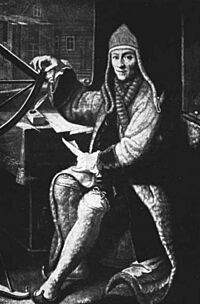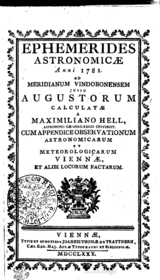Maximilian Hell facts for kids
Quick facts for kids
Maximilian Hell
Hell Miksa |
|
|---|---|

Maximilian Hell dressed in Sami clothing during his stay at Vardø in 1769 to observe the Venus transit
|
|
| Born |
Rudolf Maximilian Höll
May 15, 1720 Selmecbánya, Kingdom of Hungary (present-day Banská Štiavnica, Slovakia)
|
| Died | April 14, 1792 (aged 71) |
| Nationality | Hungarian |
| Scientific career | |
| Fields | Astronomy |
Maximilian Hell (Hungarian: Hell Miksa) was a famous astronomer and a Jesuit priest from the Kingdom of Hungary. He was born Rudolf Maximilian Höll on May 15, 1720, and passed away on April 14, 1792. A crater on the Moon, called Hell, is named after him!
Contents
About Maximilian Hell
Maximilian Hell was born Rudolf Maximilian Höll in a town called Selmecbánya, which was part of the Kingdom of Hungary. Today, this place is known as Banská Štiavnica in Slovakia. He later changed his last name to Hell.
His family was of German background, but Maximilian Hell considered himself Hungarian. He grew up in a town where German, Hungarian, and Slovak languages were spoken. He likely knew some Slovak and understood Hungarian, but German was his first language.
Exploring Languages and the Arctic
Maximilian Hell, along with another Jesuit priest named János Sajnovics, was interested in how languages are related. They studied the connection between the languages of the Sami people, Finns, and Hungarians. They explored this idea during and after their time in Vardø, a town in northern Norway. They even wrote a book about it in 1770.
Working at the Vienna Observatory
In 1756, Hell became the director of the Vienna Observatory, which is a place where scientists study stars and planets. He published important books with astronomical tables. These tables helped astronomers predict where planets and stars would be in the sky.
One of his most famous trips was in 1769. He and his assistant, János Sajnovics, traveled to Vardø in northern Norway. Their goal was to observe a special event called the transit of Venus. This is when the planet Venus passes directly in front of the Sun, looking like a small black dot moving across the Sun's face. Observing this event helped scientists figure out the distance between the Earth and the Sun.
After his trip, Hell was chosen as a foreign member of the Royal Danish Academy of Sciences and Letters. This group also helped publish his report about the Venus transit.
Clearing His Name
Maximilian Hell stayed in Norway for eight months after observing the Venus transit. During this time, he collected other scientific information about the Arctic regions. Because his results were published later than some others, a few people thought he might have changed his observations.
However, a scientist named Simon Newcomb carefully looked at Hell's original notes many years later. Newcomb proved that Hell's observations were correct and that he had not falsified his results.
Other Interests
Besides astronomy, Hell was also interested in magnet therapy. This idea suggested that magnets could help heal people. While he explored this, another person, Franz Anton Mesmer, became more famous for it.
In 1771, Maximilian Hell was also chosen as a foreign member of the Royal Swedish Academy of Sciences.
Today, the Hell crater on the Moon is named in his honor, recognizing his contributions to astronomy.
See also
- List of Jesuit scientists
- List of Roman Catholic scientist-clerics


